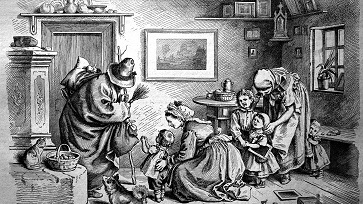
If the Christkind represents the quiet, luminous heart of the German Christmas, then the Weihnachtsmann stands at its bustling, cheerful edge. He is the figure most familiar to the outside world – the German counterpart to Santa Claus, the bearded bearer of gifts, the red-clad visitor who fills children’s shoes and stockings with treats. Yet the Weihnachtsmann is not as straightforward as he seems. He is not simply a German translation of the Anglo-American Santa, nor is he a relic of ancient folklore. Rather, he is a remarkably modern figure shaped by centuries of storytelling, cultural exchange, social change, and the evolving needs of German families.
In some parts of Germany, he has almost entirely replaced the Christkind. In others, he remains an outsider to local traditions, seen as a commercial import with little connection to the sacred rhythms of Christmas Eve. He is embraced warmly in some homes, accepted reluctantly in others, and debated endlessly in public discussions about the meaning of Christmas in a globalized world. And yet, wherever he appears, he brings with him a particular spirit of joy and familiarity – a sense of celebration rooted not in mystery but in openness.
This article explores who the Weihnachtsmann really is, how he emerged, why he spread so widely across Germany, and what he tells us about German culture today.
Who Is the Weihnachtsmann?
If you ask a German child to describe the Weihnachtsmann, the answer is usually extremely vivid. He is an older man with a long white beard, wrapped in a red or sometimes brown coat, carrying a sack of presents over his shoulder. He travels, not necessarily by sleigh, but by foot, by night, or by some magical means no one quite explains. He is cheerful, but not boisterous. He is kind, but not indulgent. He is a bringer of gifts, but also a gentle judge of behaviour.
Unlike the Christkind, who arrives silently and invisibly, the Weihnachtsmann may knock on the door. He may speak. He may read from a golden book that lists children’s virtues and occasional mischiefs. Sometimes he brings along Knecht Ruprecht, a stern companion found in older traditions who serves as a foil to the Weihnachtsmann’s generosity.
For many German children, this is their first encounter with a figure who is both magical and moral, both festive and slightly intimidating – a character who bridges the imaginative world of fairy tales and the everyday world of family ritual.
The Roots of the Weihnachtsmann: A Tangle of Traditions
The Weihnachtsmann may feel contemporary, but his origins are deeply layered. To understand him fully, we need to follow several historical threads that eventually weave together.
The influence of St. Nicholas
Before the Christmas Eve gift-giver existed, St. Nicholas reigned supreme. For centuries, children in German-speaking lands received presents on 6 December, the feast of St. Nicholas, the patron saint of children. He was depicted as a bishop, wearing a mitre and carrying a staff. He rewarded good behaviour with nuts and sweets, while his companions – such as Krampus in Alpine regions or Knecht Ruprecht in central Germany – dealt with the darker side of childhood disobedience.
St. Nicholas was not the Weihnachtsmann, but he provided the earliest structure for a German gift-giver: the benevolent visitor, the moral evaluator, the bringer of small treasures.
The Reformation and its ripple effects
When the Protestant Reformation arrived in the 16th century, Martin Luther objected to the Catholic emphasis on saints. He encouraged families to shift their focus from St. Nicholas Day to Christmas Eve. This change created a new need: a gift-bringer connected to Christ rather than to a bishop. The result was the Christkind – not the Weihnachtsmann.
Ironically, though the Christkind gained immense popularity in many regions, St. Nicholas traditions never entirely vanished. In some areas, families kept both. Over time, the figure of Nicholas began to shed his religious attributes and drift toward the secular realm.
Germanic winter figures
Long before Christianity, Germanic cultures told stories of winter visitors – wandering spirits, hairy wild men, benevolent house guardians, and nocturnal beings who roamed the forest in the dark season. Echoes of these figures persisted in German folklore.
These spirits were not the Weihnachtsmann, but they contributed imagery:
the fur-lined coat, the wintry wanderer, the mysterious stranger who appears at the door.
The rise of Father Christmas in Europe
In the 18th and 19th centuries, European cultures began creating secular Christmas figures. Britain had Father Christmas. The Netherlands had Sinterklaas. These characters mixed into German imagination through literature, travel, and political influence.
The American Santa Claus returns to Europe
During the 19th century, German immigrants in America helped shape the modern Santa Claus – especially through literature, illustrations, and emerging holiday commercial culture. Then, through transatlantic influence, this American Santa made his way back to Germany, where he blended with native traditions.
The result of all these influences is the Weihnachtsmann: a figure both local and global, both old and modern, both traditionally German and shaped by international culture.
How the Weihnachtsmann Became Popular in Germany
The Weihnachtsmann did not sweep Germany all at once. His rise took centuries, and it was shaped less by theology and more by society.
In the 19th century, cities grew rapidly. Families moved away from rural communities and their long-rooted regional traditions. The Weihnachtsmann – less tied to a specific religious or cultural context – flourished in these new environments. He offered a universal, recognizable figure in a world of shifting identities.
Illustrated children’s books, magazines, and Christmas cards spread the image of the Weihnachtsmann across German-speaking lands. He became a standard figure in stories, poems, and school celebrations.
As German Christmas markets expanded in the 19th and early 20th centuries, Santa-like figures often appeared in public spaces. The Christkind, by contrast, remained tied to the home and to religious symbolism.
In parts of Germany in the 20th century, secular authorities encouraged the Weihnachtsmann as a non-religious symbol that could unify diverse populations. This bolstered his presence, particularly in East Germany.
By the late 20th century, the Weihnachtsmann had become a nationwide figure – not universal, but widespread enough to stand beside the Christkind as one of Germany’s two main gift-givers.
The Weihnachtsmann in Modern Germany
Walk through a German Christmas market today and you’re likely to find a Weihnachtsmann mingling with the crowd, greeting children, perhaps offering sweets or posing for photos. He is a central part of public Christmas culture.
But inside the home, the picture varies dramatically.
In northern Germany
The Weihnachtsmann is often the primary gift-giver. Children write to him, wait for him, and sometimes see him in person on Christmas Eve. The Christkind is known, but not dominant.
In southern Germany
Families tend to hold onto the Christkind. The Weihnachtsmann may appear in school celebrations or shop displays, but he rarely enters the living room on Christmas Eve.
In the west and east
Both figures coexist. Some families prefer the spiritual weight of the Christkind, others the warmth and approachability of the Weihnachtsmann. In many cases, children grow up with a blend of the two.
How Children Experience the Weihnachtsmann
For children, the Weihnachtsmann is not a symbol or a cultural product. He is a real presence in their imaginative world. His visit creates a sense of joyful anticipation.
Sometimes he arrives in person. A neighbor or family friend puts on a coat and a beard, knocks on the door, and enters with a deep voice and a sack of gifts. The performance is often simple, but its emotional impact can be powerful. He asks children whether they have been kind to their siblings, whether they have helped around the house, whether they have tried their best at school. This gentle moral structure turns the Weihnachtsmann into a guide as well as a giftgiver.
Sometimes he does not appear at all. In many families, the Weihnachtsmann simply deposits gifts under the tree, and the mystery lies not in his appearance but in the surprise of his work.
In both versions, he is a reassuring figure – familiar enough to feel safe, magical enough to feel meaningful.
Weihnachtsmann and Knecht Ruprecht
In older traditions, the Weihnachtsmann did not travel alone. Knecht Ruprecht accompanied him, playing a role somewhere between helper and disciplinarian.
Ruprecht was often depicted as a darker figure – clothed in brown or black, carrying a switch or a sack. His role was not to frighten but to remind children of the moral dimensions of the season. While the Weihnachtsmann rewarded virtue, Ruprecht addressed misbehavior.
In modern Germany, Ruprecht has become less common, especially in urban areas. Families today prefer a more gently encouraging Christmas experience. But echoes of the older relationship remain in stories and regional customs.
The Weihnachtsmann and the Christkind: A Cultural Dialogue
The coexistence of these two gift-givers creates one of the most fascinating aspects of German Christmas culture. It is rare for a country to maintain two parallel figures, each with its own rituals, imagery, and emotional tone.
The Christkind is quiet, luminous, and sacred. The Weihnachtsmann is warm, visible, and secular.
The Christkind brings gifts silently. The Weihnachtsmann may knock and speak.
The Christkind belongs to the space of candlelight and reverence. The Weihnachtsmann belongs to the space of celebration and community.
Families choose between them not just based on what children prefer, but based on what kind of Christmas atmosphere they want to cultivate. The Christkind encourages stillness and reflection. The Weihnachtsmann encourages warmth and festivity.
The result is a cultural richness that gives German Christmas a complexity many visitors do not expect.
The Weihnachtsmann in Letters and Post Offices
Just like children who write to the Christkind, children also send letters to the Weihnachtsmann. Several towns serve as official “Weihnachtsmann post offices.” Children receive warm, personalized replies that nourish the magic of the season.
These letters reveal the emotional landscape of German childhood – hopes, fears, wishes, and confidence that someone out there cares deeply enough to listen.
The Cultural Debates Surrounding the Weihnachtsmann
In recent decades, the Weihnachtsmann has become the subject of cultural conversation in Germany. Some argue he is an imported, commercialized figure overshadowing older traditions. Others defend him as a cheerful, unifying presence that helps children experience joy.
The debates themselves say something important: Germans think deeply about their traditions. Christmas is not simply consumed – it is considered, cherished, protected.
Ultimately, no figure can replace families’ lived experiences. Whether the Weihnachtsmann or the Christkind stands at the center of the celebration, what matters most is the story each family tells, year after year.
Why the Weihnachtsmann Endures
The Weihnachtsmann remains a remarkably resilient figure. He endures because he is flexible, adaptable, and easy to personalize.
Families can reinterpret him as needed – playful, moral, warm, quietly magical, or even humorous. He is not tied to a single theological message, which allows households of many backgrounds to embrace him.
He also endures because he brings a sense of community. Seeing a Weihnachtsmann at a Christmas market, waving to children, creates a feeling of shared celebration. He belongs not just to homes but to streets, squares, and city lights.
Above all, he endures because children love him. They write to him, imagine him, draw him, and eagerly await him. For them, he is not a symbol of commercialization, but a bearer of joy.
The Weihnachtsmann is more than a German version of Santa Claus. He is a cultural figure shaped by centuries of storytelling and social change, a bridge between old traditions and new ones, and a companion to the quieter, more spiritual Christkind.
He brings not mystery, but warmth. Not silence, but shared celebration. Not secrecy, but presence.
Together, the Christkind and the Weihnachtsmann form the two poles of the German Christmas experience – one inward, one outward; one sacred, one festive. It is this duality that gives the holiday in Germany its special emotional richness.
And whether he comes knocking at the door or slips in unseen, whether he carries a book of virtues or simply places presents under a shining tree, the Weihnachtsmann continues to hold a beloved place in German hearts.
Related articles:
Christmas traditions in Germany
German Christmas Tree: Tannenbaum History and Traditions
Christmas Celebration in Germany
Christkind in Germany








